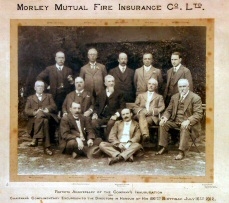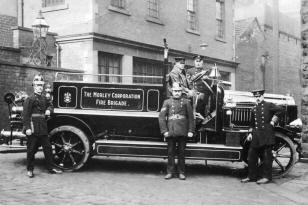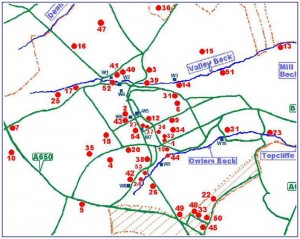Services discussed:
Fire Brigade

By 1872, Morley had over 20 mills engaged in the manufacture of cloth, and the owners were not happy about the high fire insurance premiums, so they decided to form a company of their own, and The Morley Mutual Fire Insurance Company came into existence on 18th June 1872. A steam fire-engine was purchased at a cost of £800, and eleven part-time firemen were recruited, with George Albert Firth being appointed Captain of the brigade. The fire-engine was drawn by two horses loaned from James Clegg and Sons and when a fire was notified they were harnessed and then released. They would gallop on their own down Wesley Street, across Queen Street and a short distance down Peel Street to the fire-station. No mains water supply was available, but underground water tanks had been built at strategic points and water from mill dams was often used. Mill fires were very common and some mills were never rebuilt after having been devastated by fire. These include Low Moor (Sarah Dixon’s), Albion Mills (R & J Horsfall), Rods Mill (Isaac Watson), Daisy Hill Mill and Hembrigg Mill.

Morley Council became responsible for fire-fighting in the Borough in 1902, and the service became known as the Morley Corporation Fire Brigade. In 1906, new premises were erected in Wellington Street, behind the Town Hall. The Leyland and Dennis machines were brought into service in 1921, the pumps being driven from the engine’s motor system, which was a tremendous step forward.
The Morley Mutual was taken over by the London and Lancashire Insurance Company in 1916 after a series of disastrous mill fires at the beginning of the Great War. The most serious of these took place in the rag-grinding sections of the mills concerned.

The textile trade in Morley began to die out after the Second World war but three fires on note occurred before all the mills closed down.
On 11-February 1944, the Hembrigg Mill off Bridge Street was gutted by fire in two hours. It resulted in the death of three workers (two sisters, Alice and Sarah Shipley, Thomas Walsh) and two firemen (Section Leader Cromwell, Leading Fireman Duthoit).
On 16-June-1950 the Albion Mill on Church Street was destroyed by fire but with no loss of life.
On 18-August 1961 rags in the Albert Mill on Wellington Street caught fire and sparks from this spread to the nearby Town Hall resulting in the loss of its dome.

The acquisition of new machinery, the Service grew in strength, and just before WWII it was put on a full time basis. The Corporation ran a well-equipped Brigade of 24 men, and the equipment included Leyland and Dennis petrol-driven engines, fire escapes and other apparatus. An Auxiliary Fire Service of part-time firemen was formed in 1938 and occupied an empty building in Wesley Street, becoming the N.F.S in 1941. The Borough Brigade continued using the Wellington Street station until 1940, when the whole of the fire-fighting service became based in Wesley Street. On 1st April 1948, the Morley Fire Brigade came under the jurisdiction of the West Riding County Fire Authority. The present Fire Station in Corporation Street was built in 1961, and officially opened on 17th February 1962 by the Mayor, Councillor L.J. Finnigan.
The fire service in Morley continues to operate and The public owes a deep debt of gratitude to them for their prompt attention in dealing with fires and saving lives.
Water

On the map above, W indicates a well for drinking-water. The red dots indicate the location of mills in the town, blue lines indicate waterways and green lines show the principal highways.
Gas and Electricity
to be added.
Ambulance
to be added.
Police
to be added.

You must be logged in to post a comment.